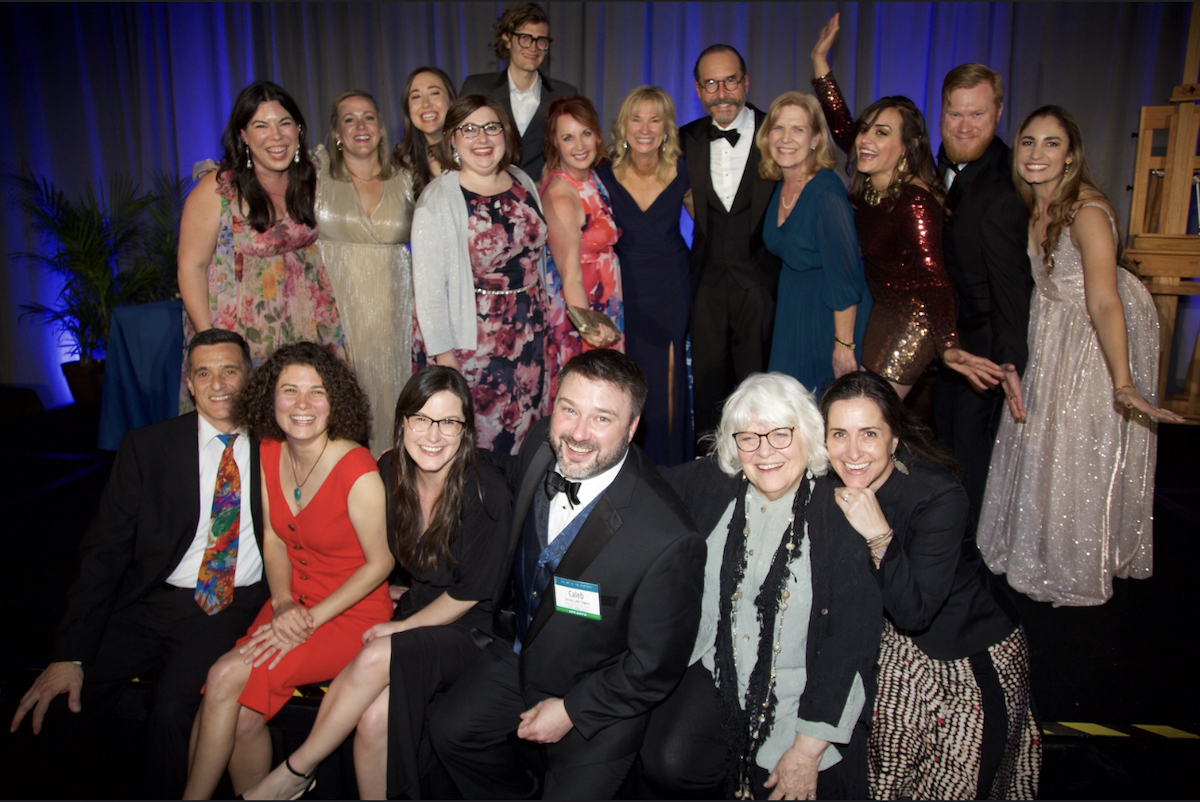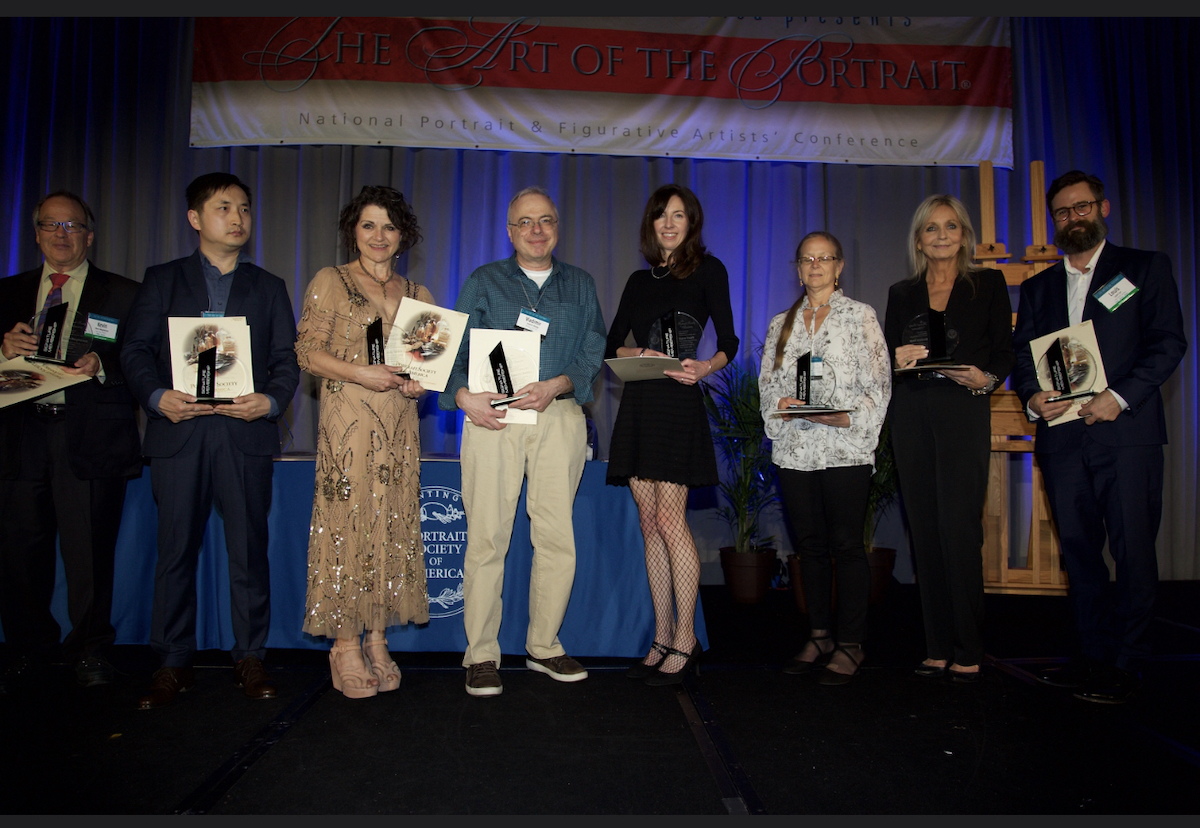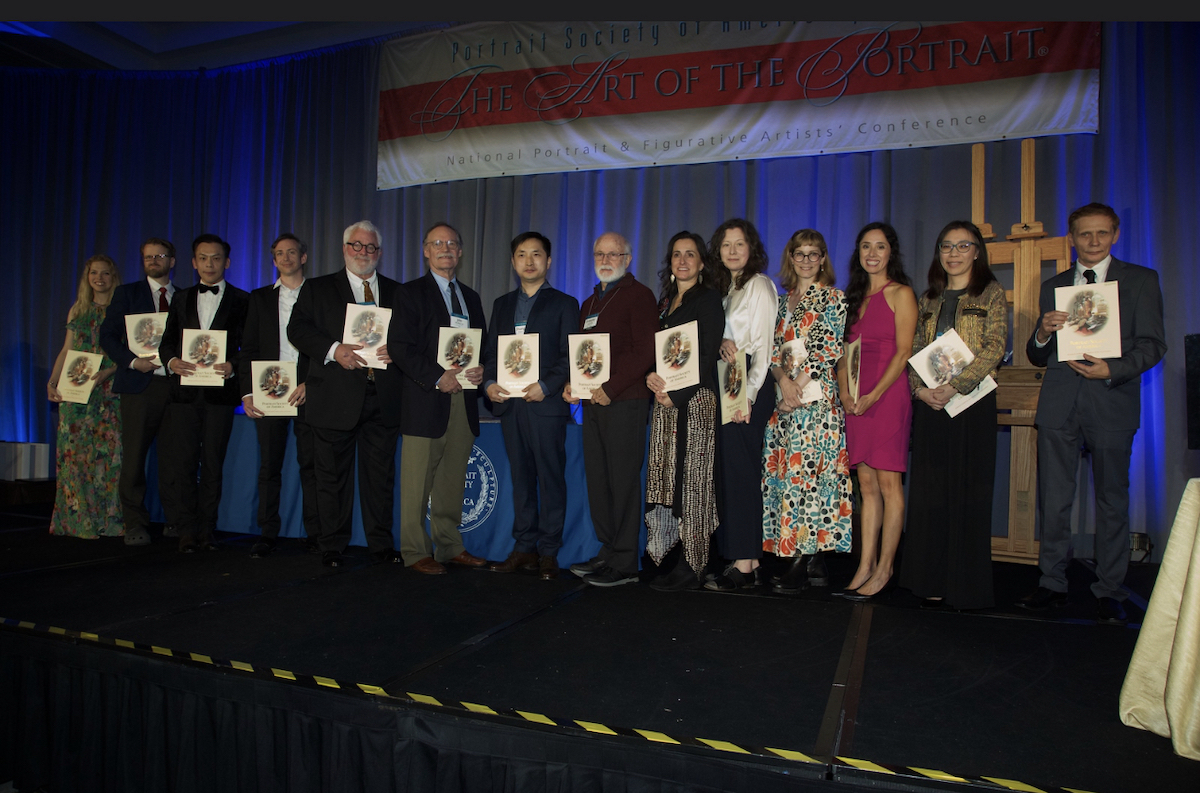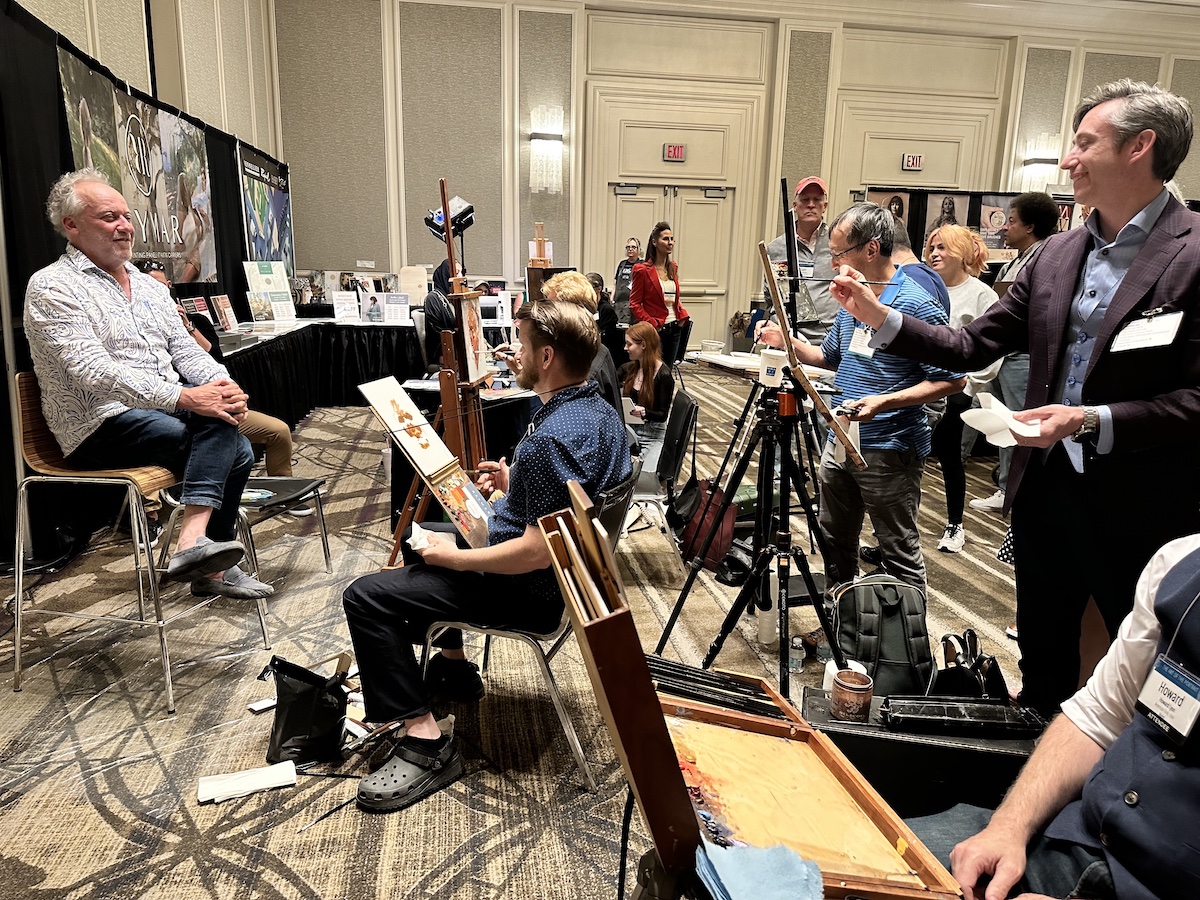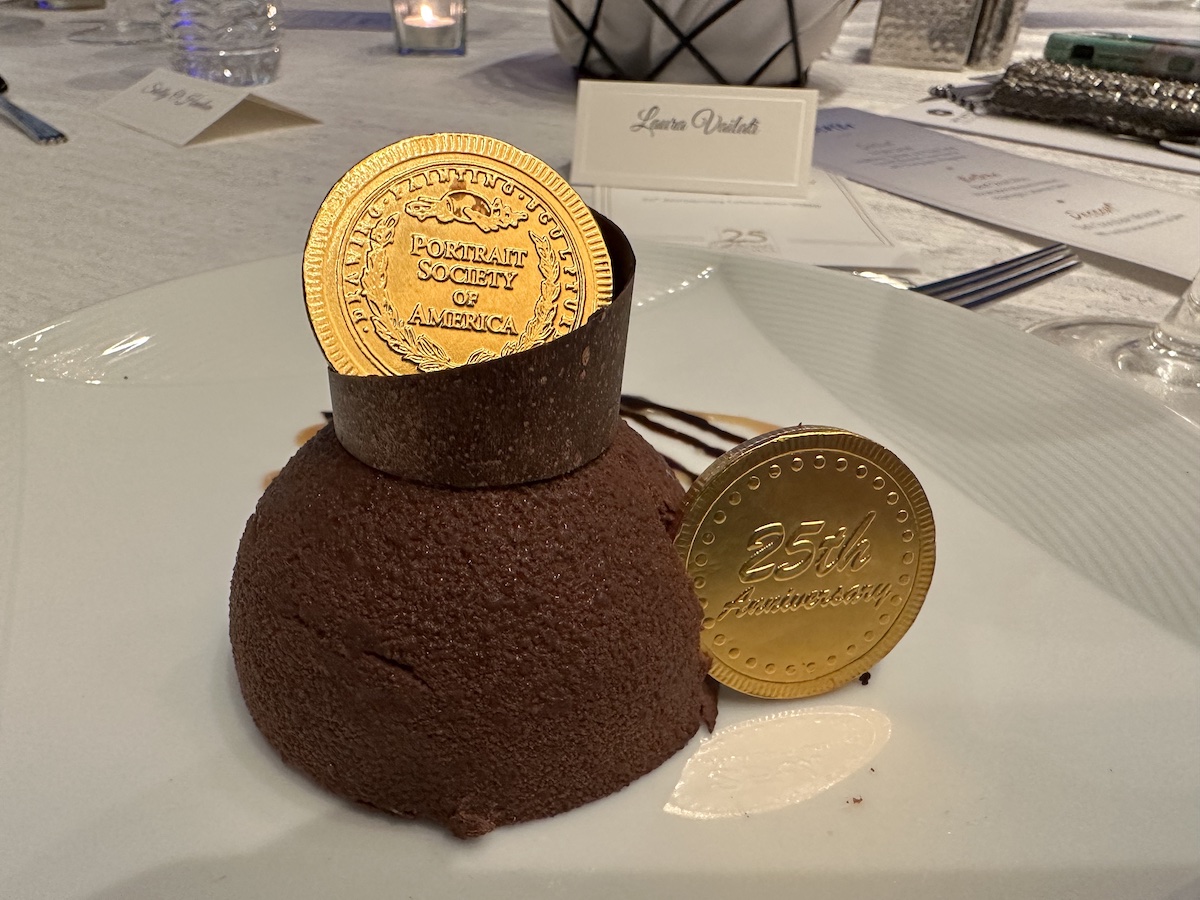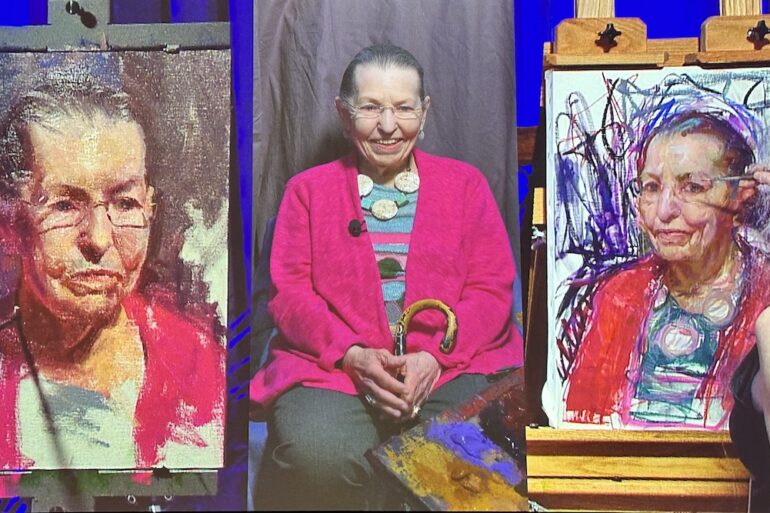
This post is also available in:

The daily article opens with the announcement of the winners of the XXV edition of The Art of The Portrait: the annual conference established by the Portrait Society America, which celebrated its XXV anniversary this year.
The event celebrated as usual, at the end of the Gala Banquet and Awards Presentation of the institution’s XXV anniversary, celebrated, among others, the winners of the prestigious “International Portrait Competition” who were: Shane Wolf, with the work “Distanciation” in the drawing section; Joe Lou, with the work “Hsin P. Soh,” in the sculpture section; and Alex Venezia with the work “Autumnal Hymn” in the painting section.
The People Choice Award winner was Ruth Fitton with the work “The Abduction of Time.”
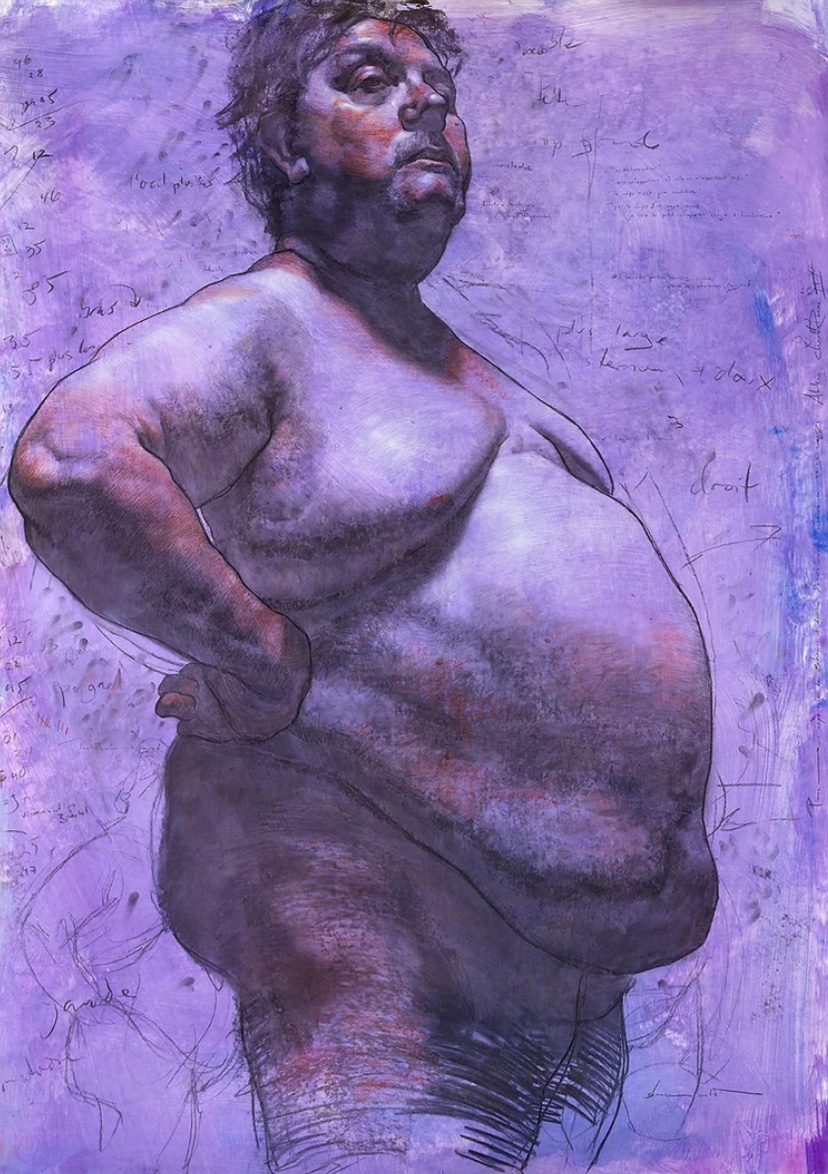
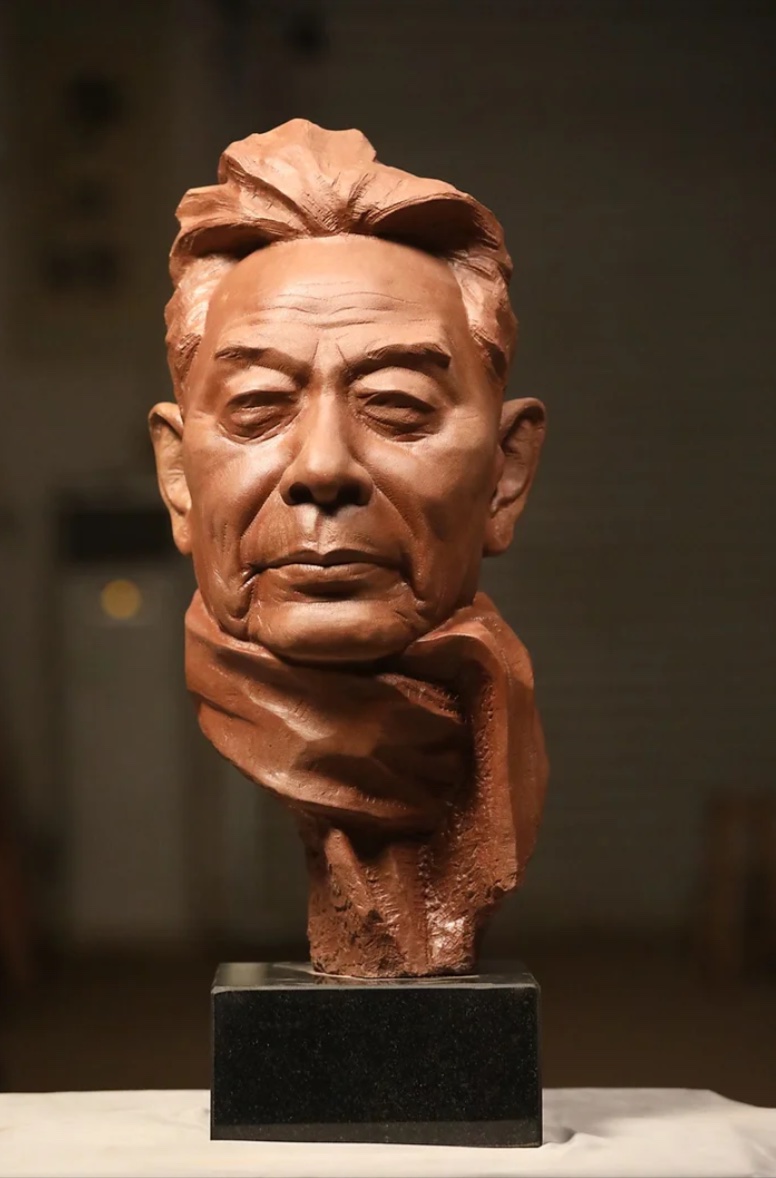
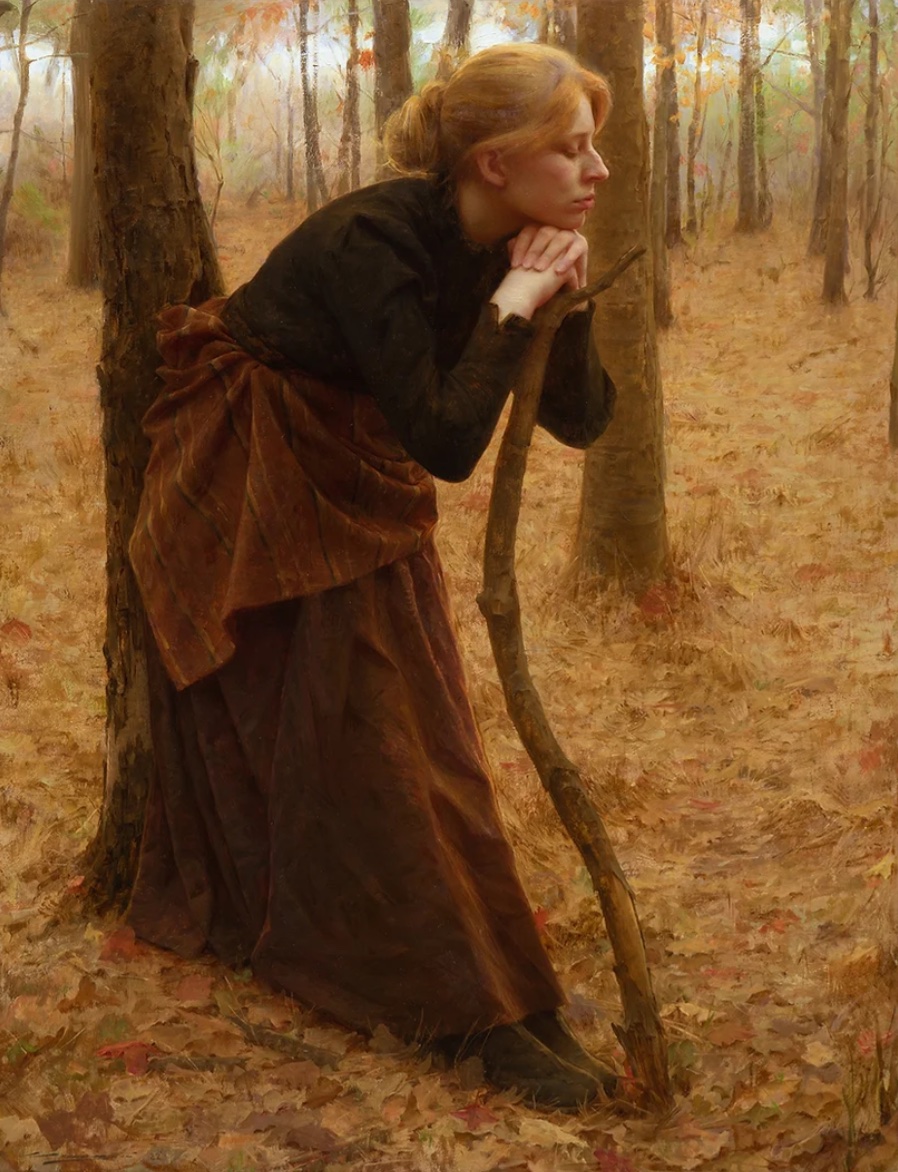
The winner of the prestigious and coveted Draper Grand Prize, 2023, was Australian artist Paul Newton, whose work “Self-portrait in Lockdown” received the hefty $50,000 prize. He excitedly declaring, “I dedicate my win to my family and all Australians who, like me, have experienced the long and restrictive lockdown imposed by the Australian government.”
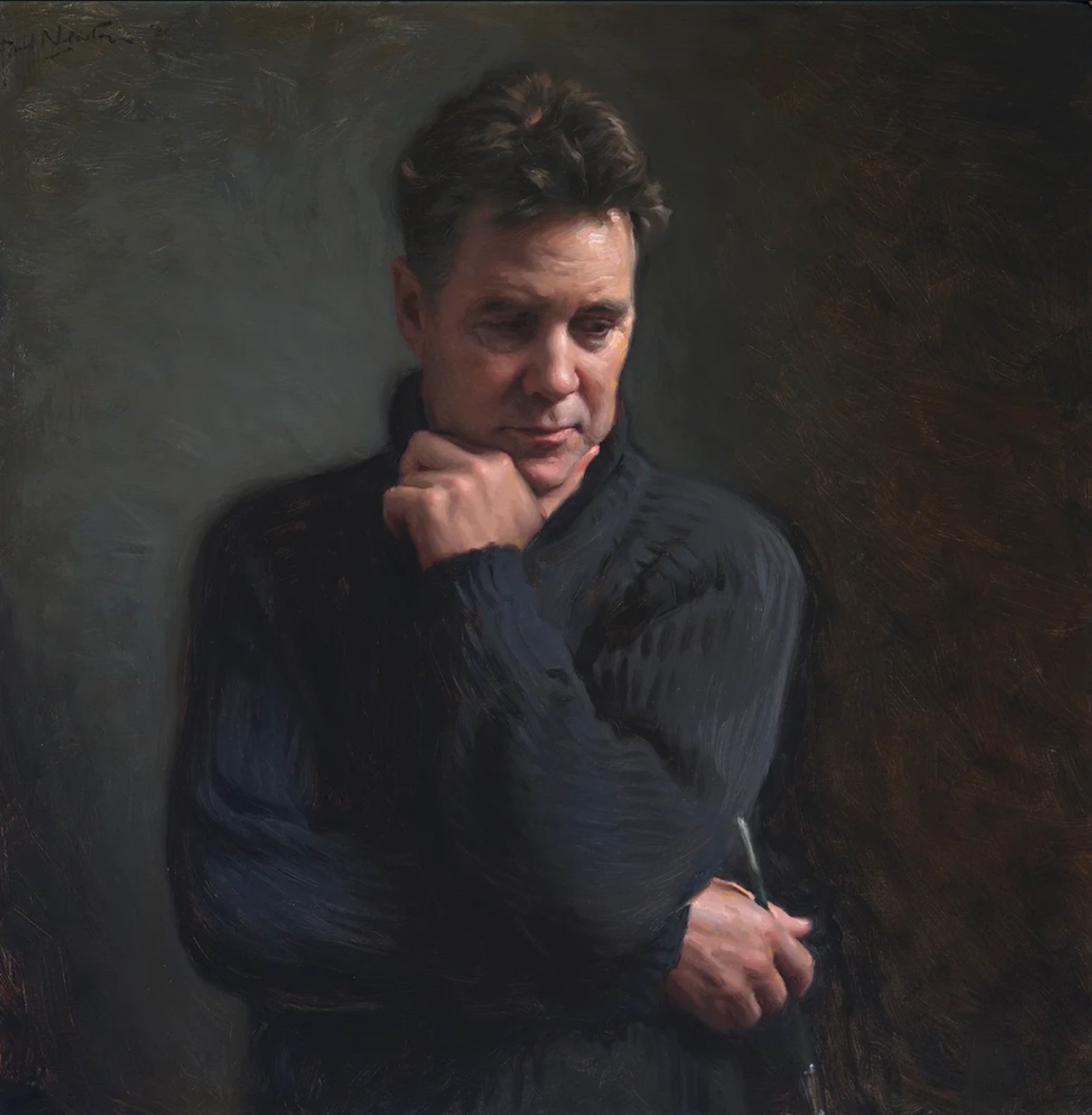
Running through most of the day’s demonstration sessions was the theme of painting from photographic reference. A topic that has always been a source of discussion among artists even before the COVID-19 pandemic that further amplified its use.
A modality that today can be useful regardless, if approached correctly, even by artists who prefer representation from life.
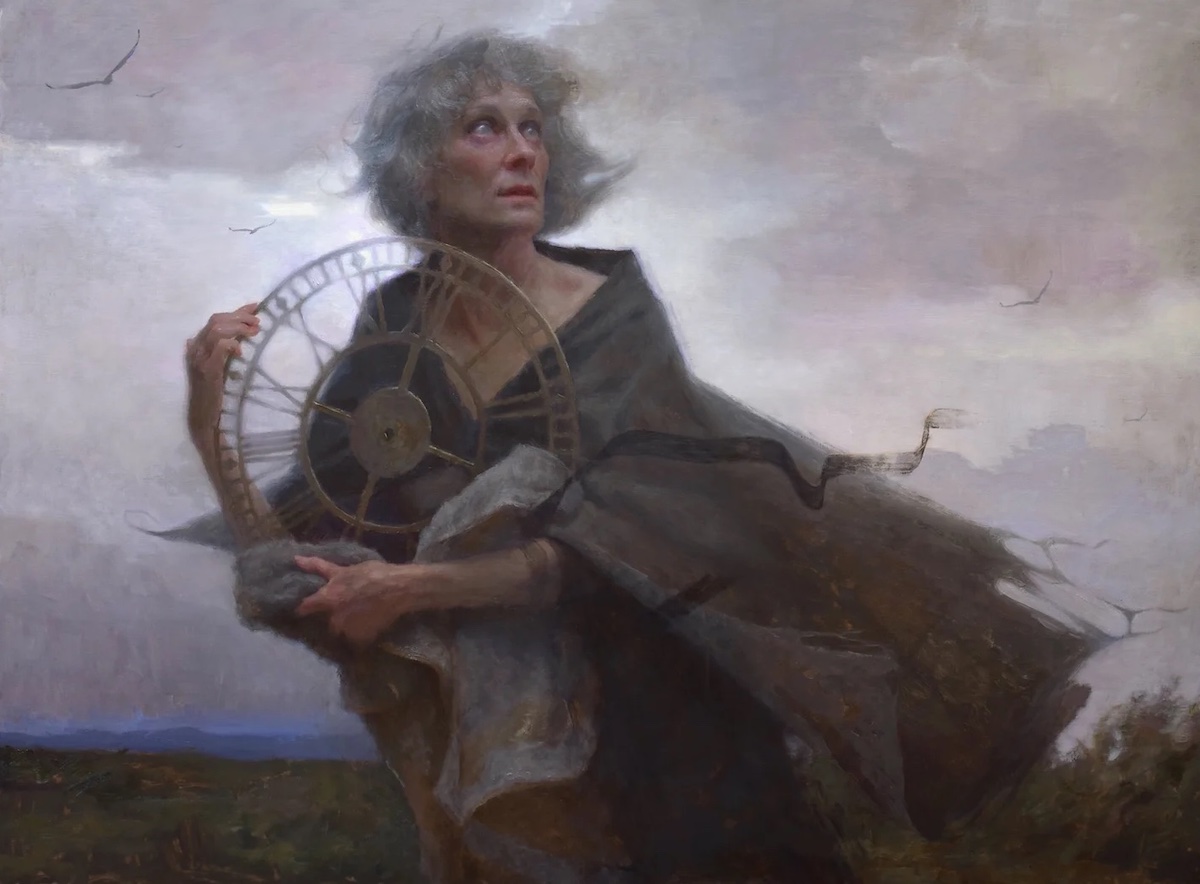
The first -discursive- session of the day, entitled “Moving Targets,” featured James Gurney, Michael Shane Neal, Mary Whyte and Wende Caporale.
Through personal vicissitudes and anecdotes-even funny ones-the four, referring to their painting experience, highlighted the pros and cons of this approach to painting that has taken on very high levels.
“It’s very valuable to use photographs as a resource,” said Michael Shane Neal bringing concrete examples both personal and from other artists, including his mentor, Everett Raymond Kinstler.
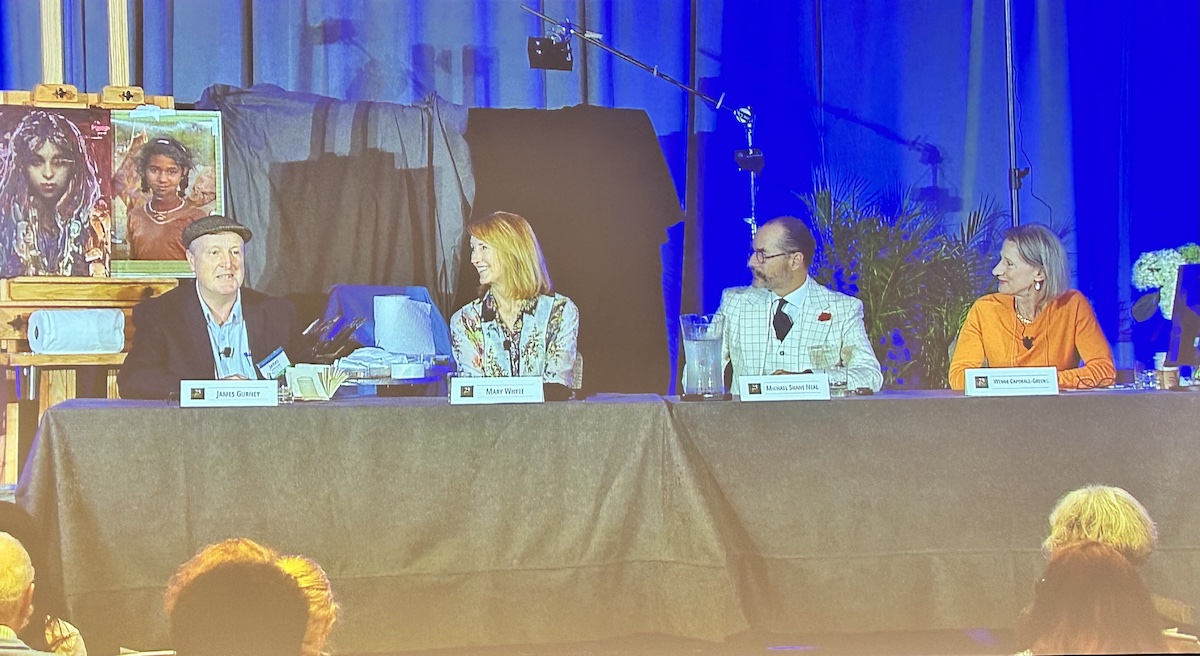
A frame of the panel discussion “Moving Targets” by James Gurney, Michael Shane Neal, Mary Whyte e Wende Caporale.
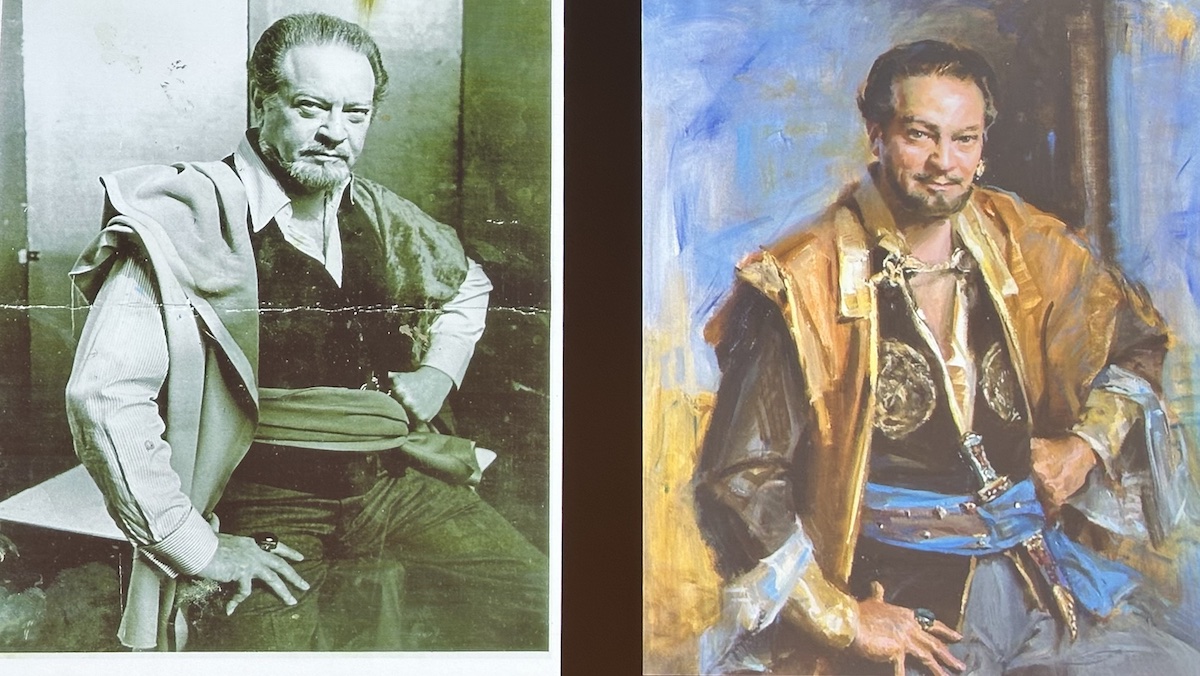
Bringing up her work for the “We: The People” project as an example, Mary Whyte said how photography represents one of the four resources she takes into account in making her paintings. The other resources are: live painting, memories and imagination. “My painting is a combination of these four elements, but my priority source always remains that of a ‘genuine human approach to people,’ which allows for a focus on elements whose complexity cannot be captured by a static photographic shot, which can instead be used to complement it.” , Whyte said.
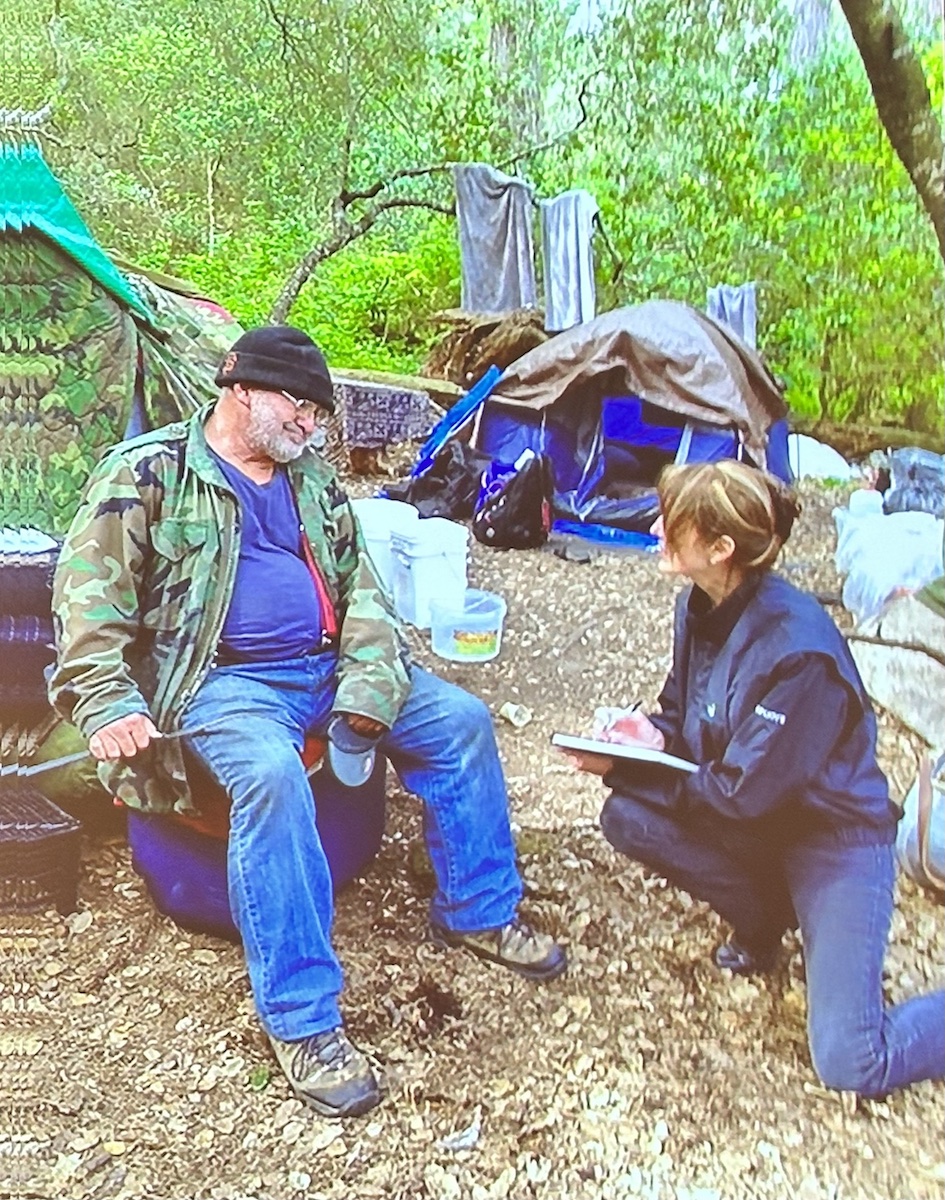
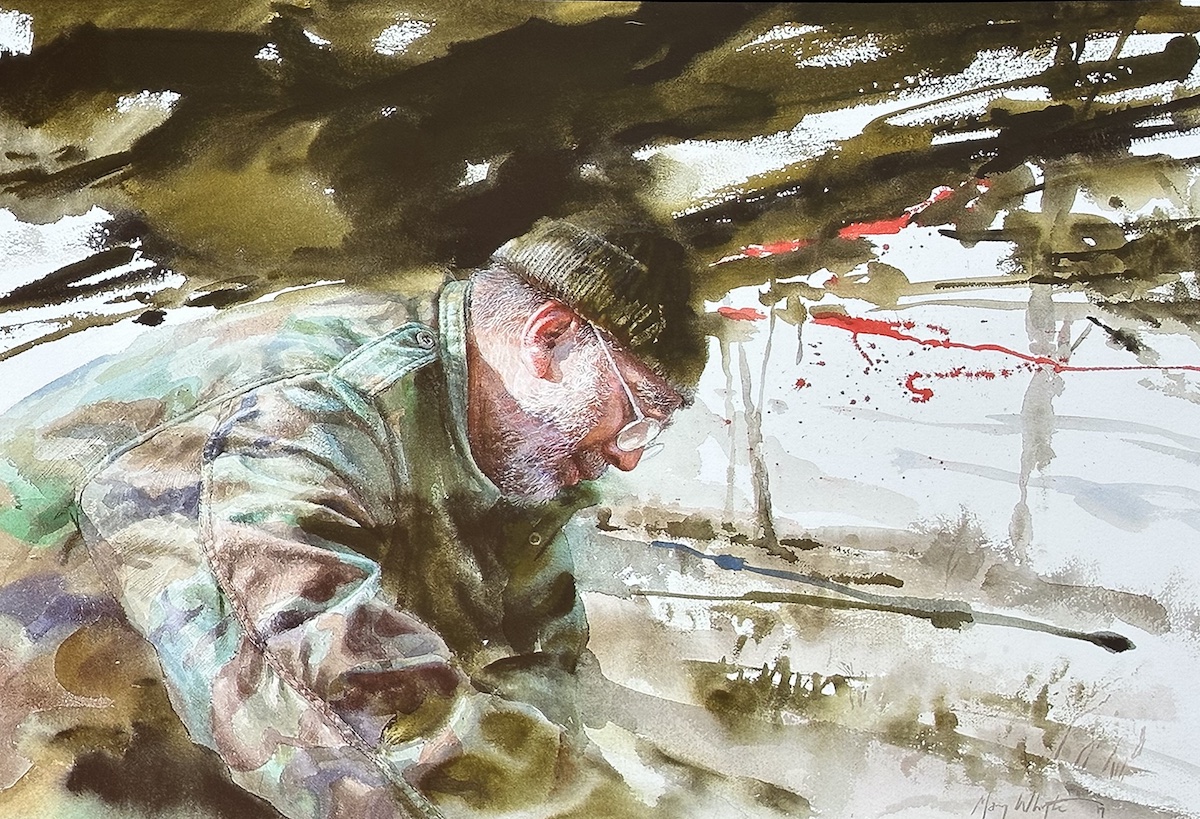
On the other hand, the use of memory and imagination are the characterizing elements in the artistic process of Wende Caporale, who uses photography exclusively as an additional support in the realization of her compositions.
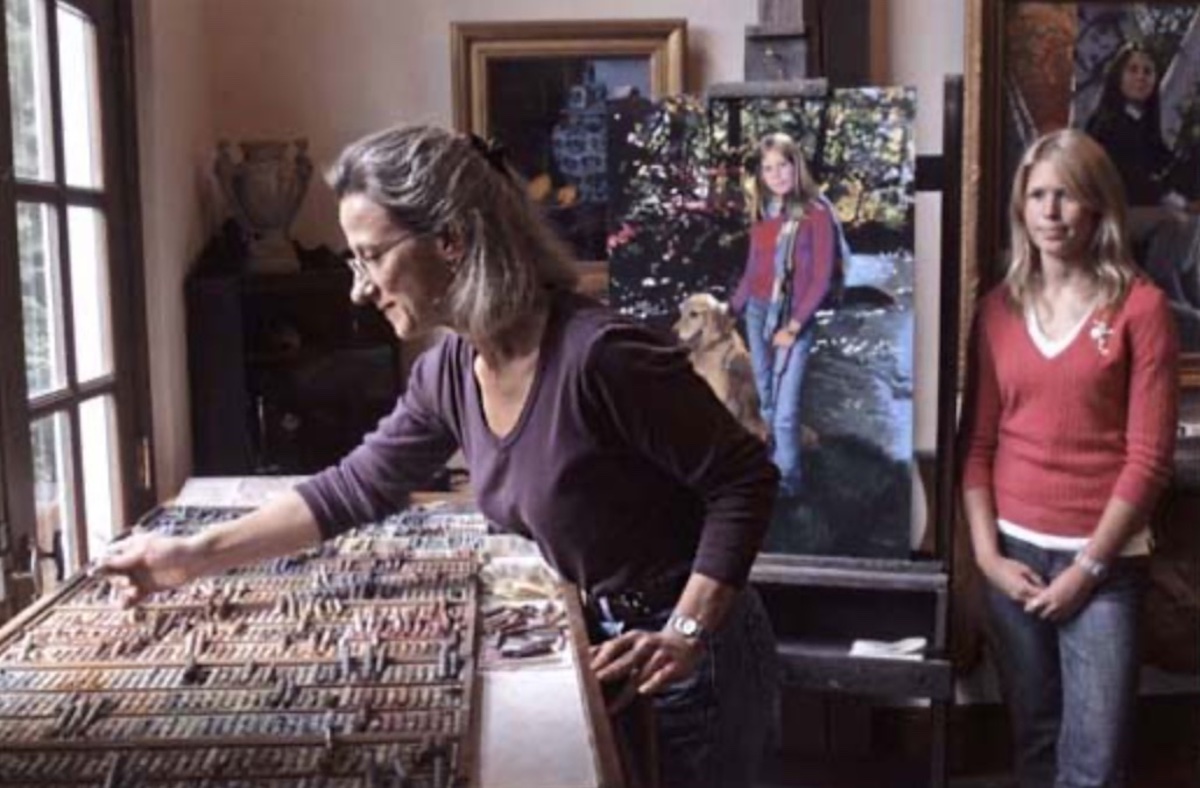
Of a different opinion is artist James Gurney, who said he prefers making video recordings to photographic images, as their dynamism -as opposed to the static nature of photography- allows the artist to focus on details that may elude the human eye, which is focused on capturing the essence of the person. “Trough the video you can understand exactly what you have to say in your painting,” he says.
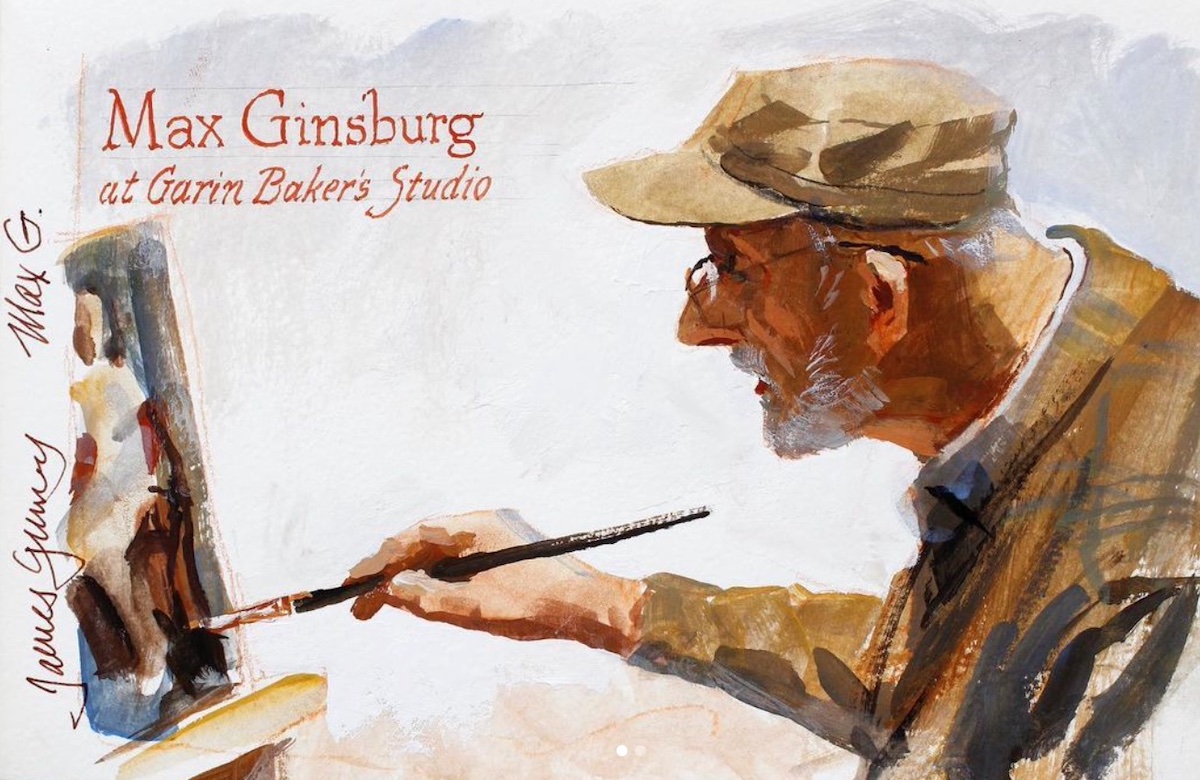
Of a different opinion is Max Ginsburg, “the painter of the people,” one of the most important narrative voices of our time. With a remarkable open-mindedness and flexibility of thought-paradoxically in contrast to his ninety -one years of age, which place him almost in another era- Max Ginsburg argues that the use of photographic images is a process most often underestimated by artists but which, on the contrary, can be very useful in the representation of supporting elements-such as background and details.
However, Ginsburg makes a distinction between: “candid photos,” made spontaneously among , for exemple, the streets of New York, and “photo shoots,” made instead in the studio with predetermined objectives and aimed at a precise pictorial construction.
Assuming that the people who inhabit his compositions-especially complex ones such as, “The Bus Stop”-are portrayed individually in the studio and “assembled” together in the final composition, Ginsburg argues that: “Teaching is not just talking but it is also showing a photographic image that contains hundreds of condensed words: you just have to choose what to say and extrapolate it, modifying it to your liking according to your compositional needs.”
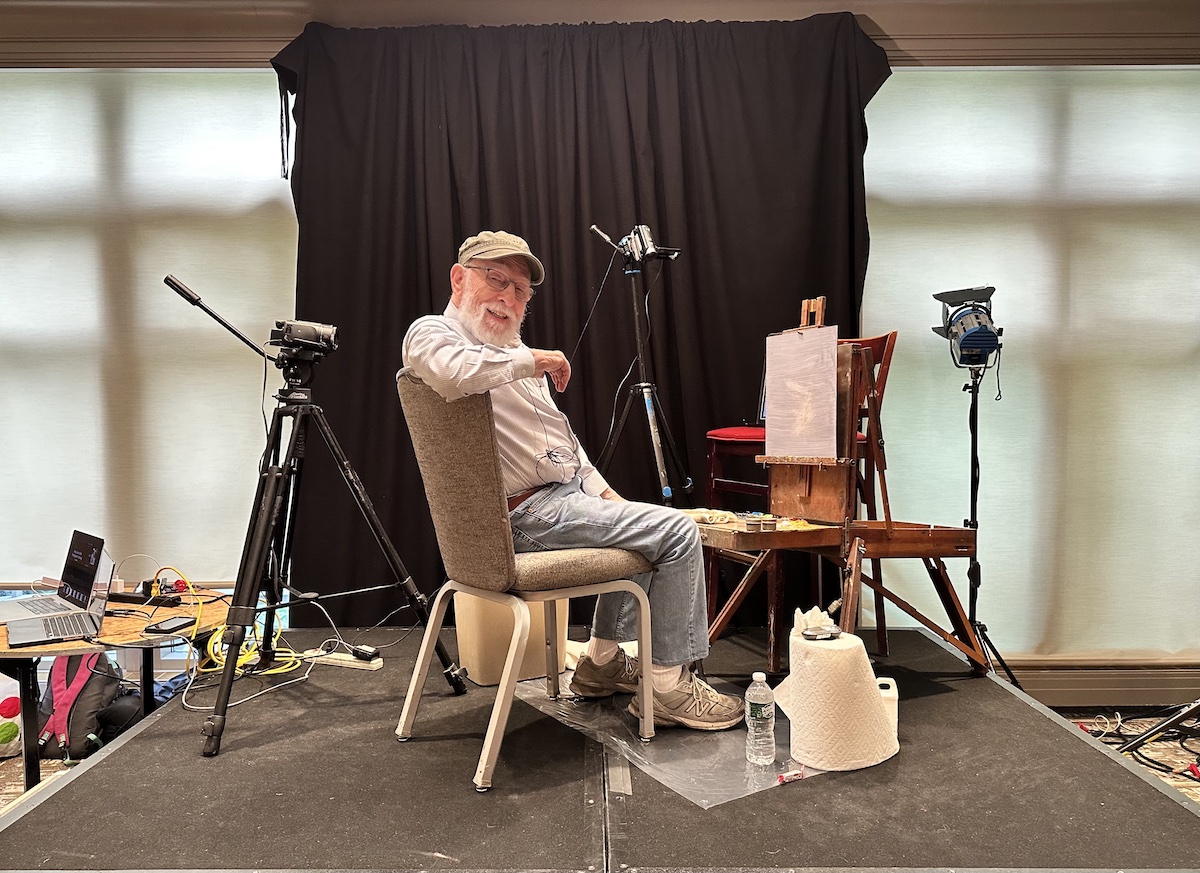
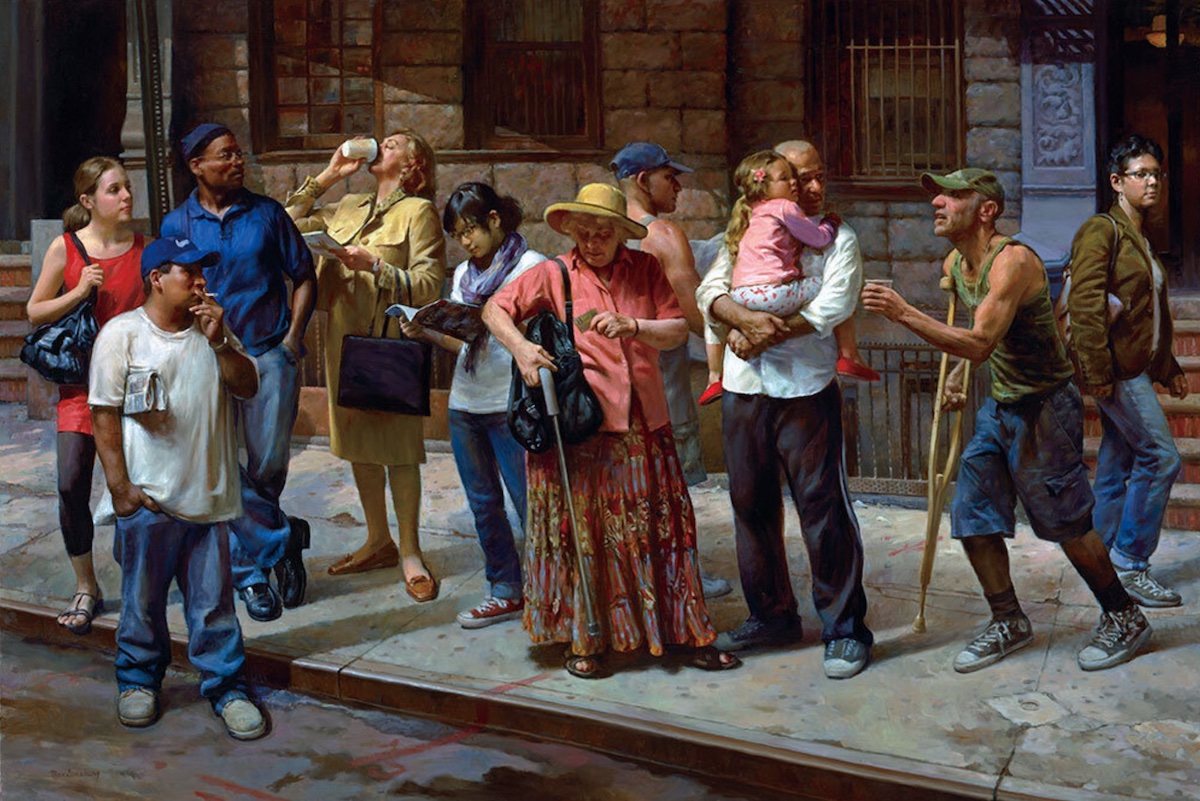
Suchitra Bhosle and Scott Burdick were the stars of the “On the Road” session, created from photographic references taken personally during a stay in Bhosle’s native India.
Working with a rich color palette, characterized by two distinct painting styles, the two highlighted the beauty and folklore of Indian culture, which can be widely perceived in their works.
“I love meeting people and any excuse is good to dialogue and interact with them and learn about their culture and stories. Dialogue and interaction are the essence of travel for me,” said Scott Burdick who defines travel as: “the exaltation to the nth power of the human experience.”
Suchita Bhosle, on the other hand, argues that through the experience of travel, all the beauty of human singularity emerges: “All the people go to the same place and yet each of them focuses attention on something different – it is a matter of personal sensibility that emerges later in the paintings.”
Always relating with kindness and respect, both Burdick and Boshle argue that drawing or painting in place invites people to interact, creating a connection that is impossible to establish through the photographic image alone. And it is through this connection, fixed in the hundreds of photographs taken by both artists, that emotional nuances emerge that bypass the static nature of the photograph reaching the heart of the viewer viewing the final painting.
According to Burdick, in order to achieve a correct photographic image, especially one of the human figure or portrait in particular, it is necessary to shoot at a distance of six feet so as not to distort the image.
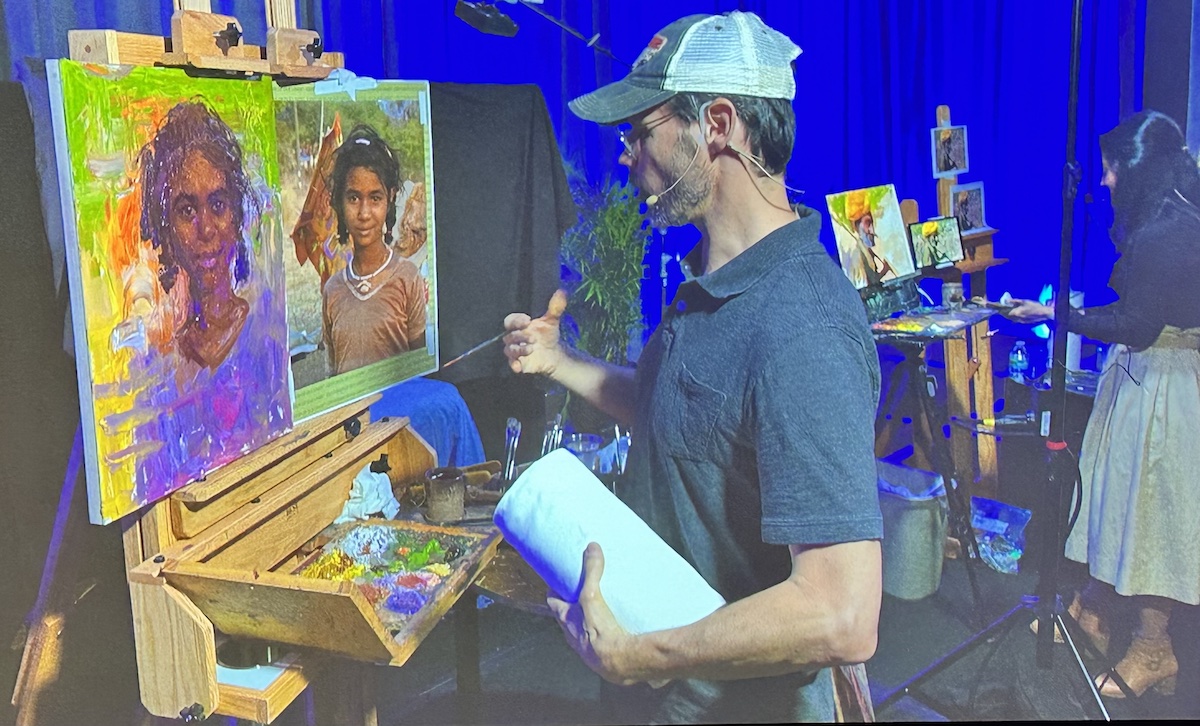
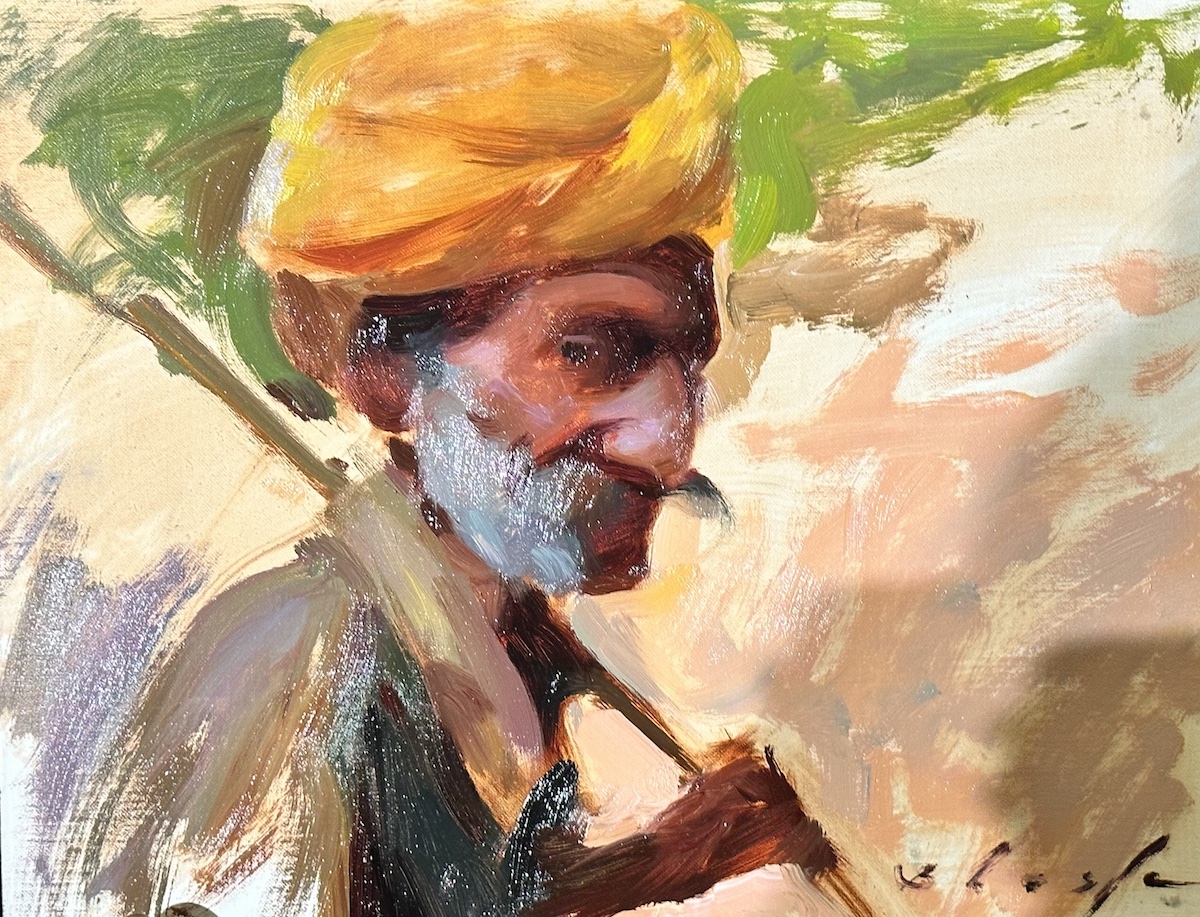
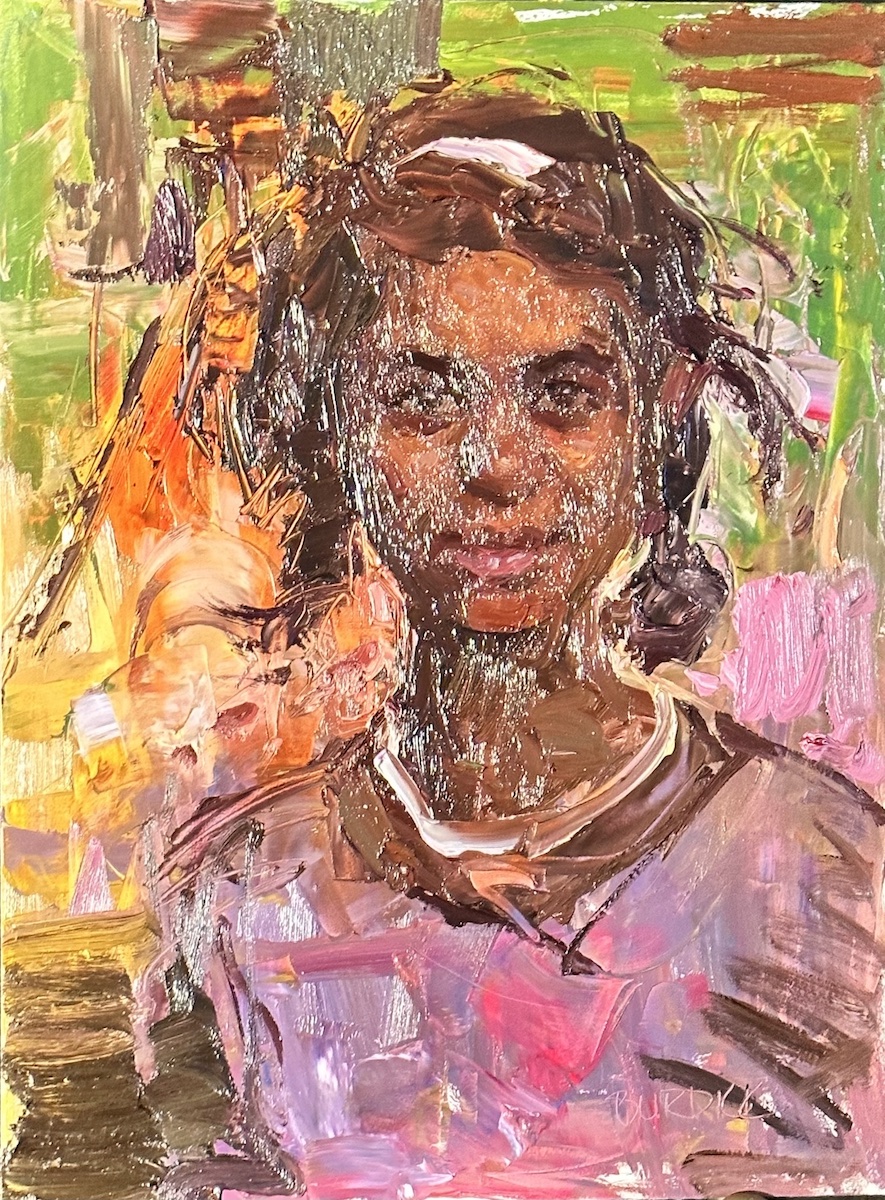
According to artist Dominique Medici, making a “Quick Sketch with a Limited Palette” is a valid system for simplifying forms and tonal values. Endowed with a strong proactive spirit, after pointing out the principles that regulate the realization of a correct pictorial composition -which are: proportions, the study of tonal and chromatic values, and the rendering of edges- the artist stated how, “In colors all is about relations.”
In the realization of the composition, to the variations in color temperature, she created a connection between the parts by inserting mid tones.
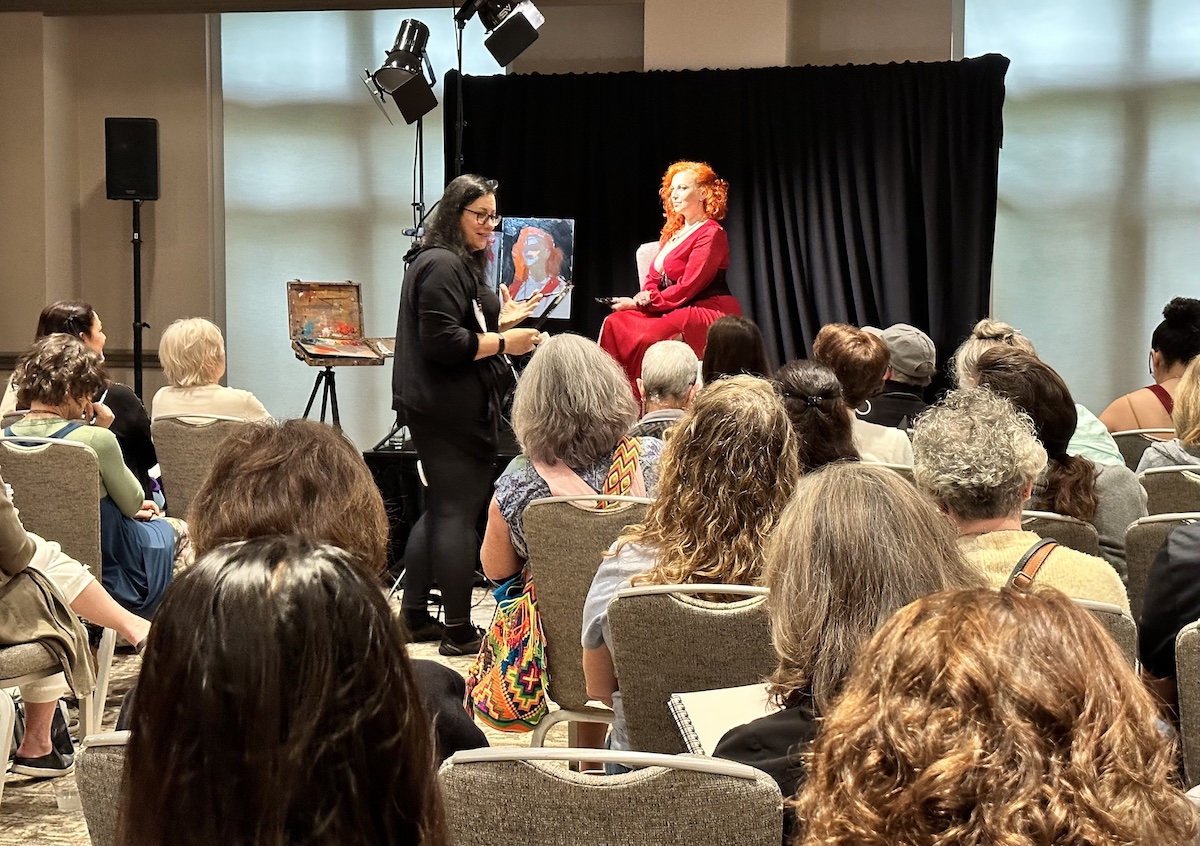
In the demonstration session of “Portrait Sketch in Pastel,” eclectic artist Daniel Keys included an interesting provocation by saying, “How many times have you heard that it is necessary to squint in order to focus tonal values? Well, that’s not true,” specifying then that the operation of squinting, an end in itself is useless if it is not accompanied by comparisons between the parts.
The artist, who created the portrait of Daisy, one of the convention’s models characterized by very strong and expressive physiognomic features, started from the realization of the five shaded points to be taken into account in the composition of the portrait: the eye socket, the base of the nose, the upper lip, the under lip and the chin, without spending time in the realization of the initial block-in.
The artist, who arranges the rich color palette in a functional manner by distinguishing pastels by tonal and chromatic value, said he uses harder or softer pastels -with a reference for the latter- varying according to the compositional stages: softer in the initial drafting stages and harder in the rendering of details.
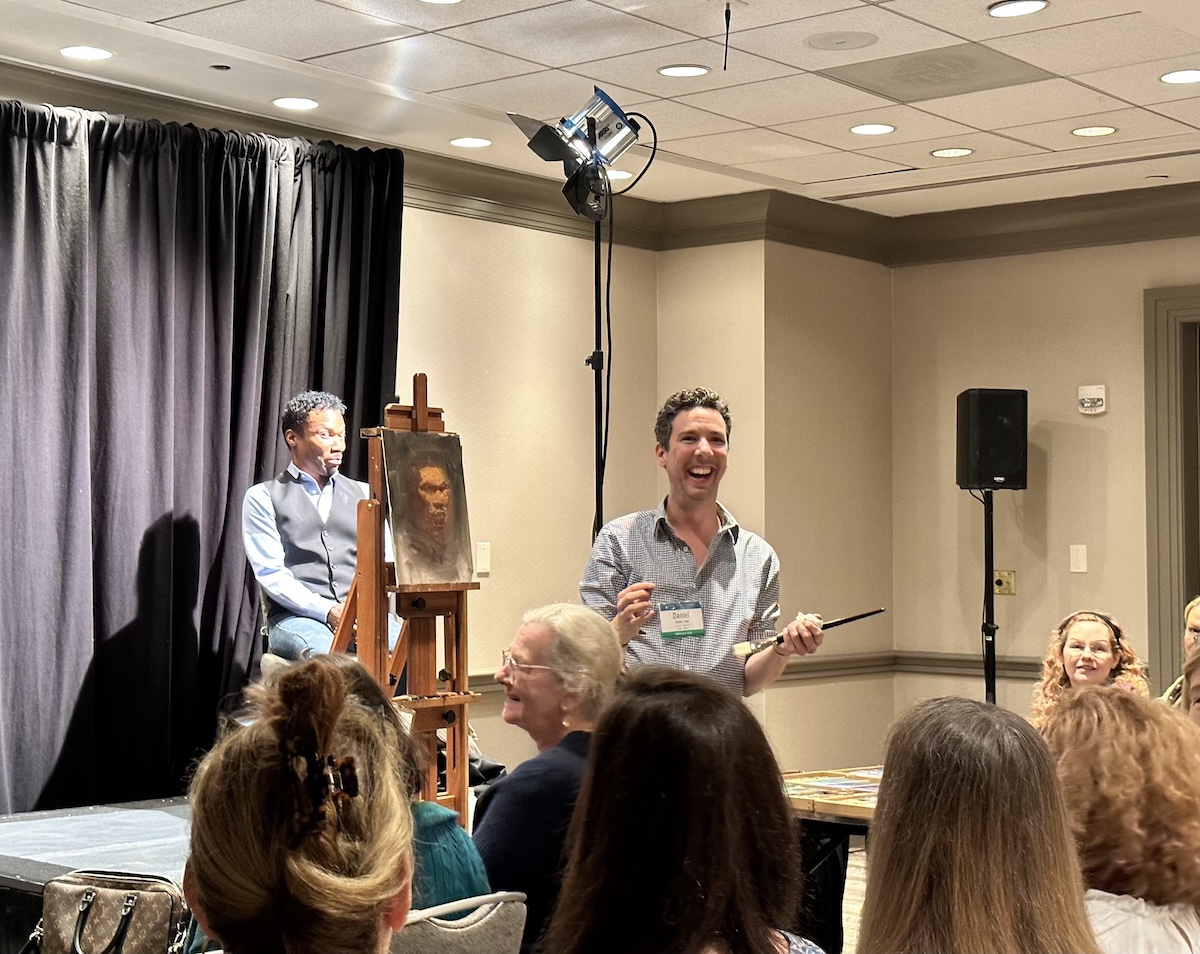
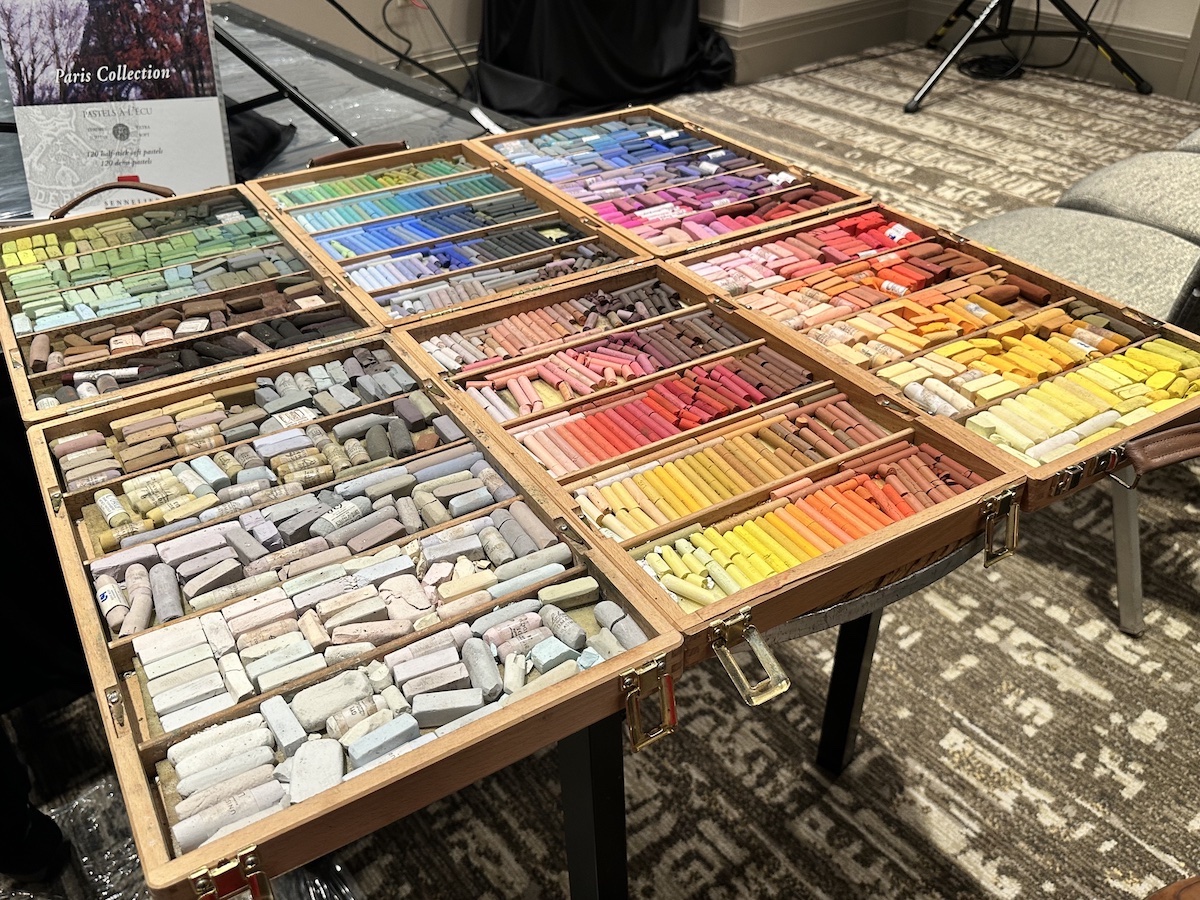
In their demonstration session, “Strengthening Drawing Skills,” Dawn Whitelaw, esteemed artist and teacher, and Thomas Caleb Goggans, among the Face-Off artists, focused on shapes and their rendering from visual memory, a valuable exercise that Whitelaw insists on heavily in her classes.
Participants made quick compositional sketches in a limited time frame -10 minutes- under the guidance of the two faculty members. ” Making sketches in a limited amount of time helps define the big shapes while avoiding getting lost in the details,” Whitelaw said.
“Emphasizing the unity of the effects and the drama that you can achieve through simple statement of the shadows and the lights just simple emphasizes what is essential,” Goggans added.
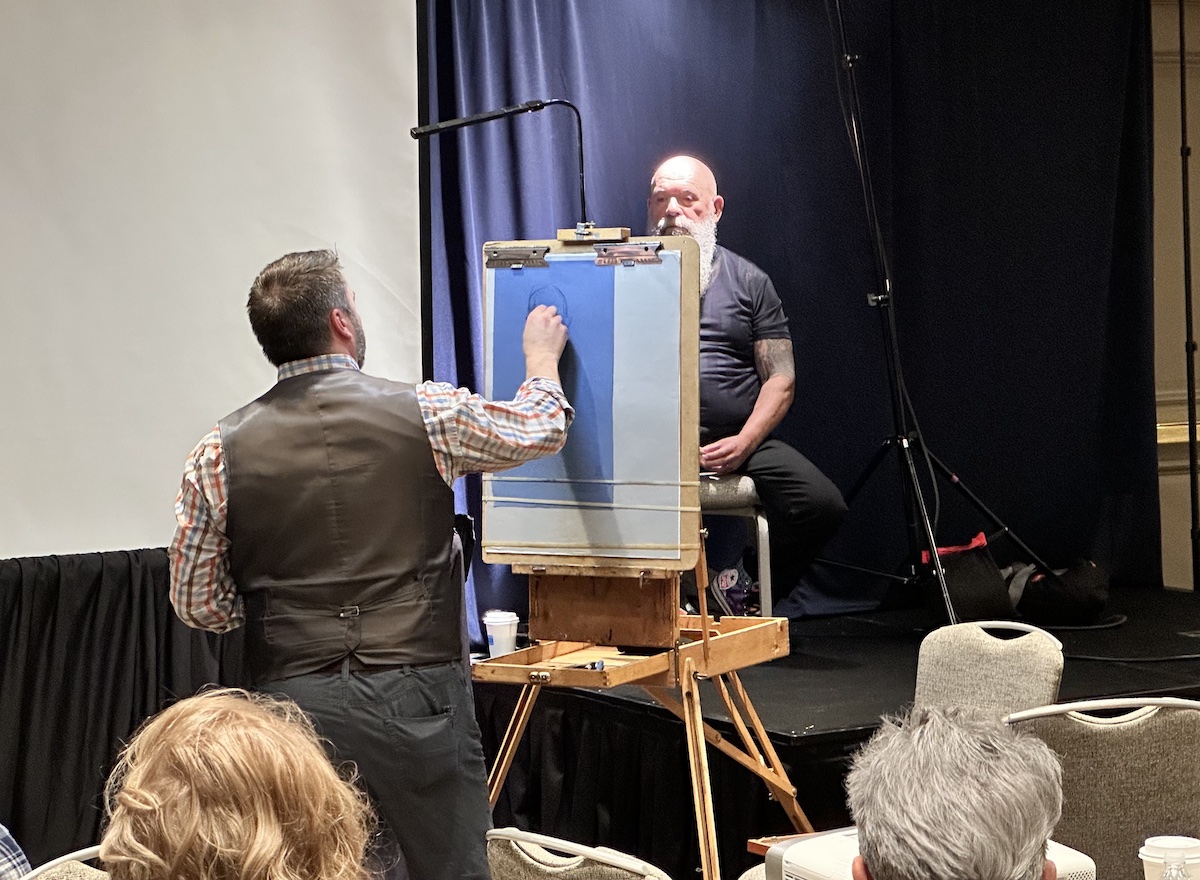
The last demonstration of the day was an event to remember: the extraordinary Rose Frantzen and Jeff Hein performed a demonstration entitled, “All Things Art.”
The two singular artists -who need no introduction precisely because of the technical and linguistic dynamism that characterizes them- didn’t dispense special teachings as much as they delivered a real show in which fun reigned supreme from beginning to end in a constant exchange of jokes and provocations that entertained the audience. While Frantzen’s technique is characterized by the total abstraction with which she approaches, above all, the initial stages of composition, Jeff Hein executed the portrait in a more rigorous manner with an underpainting done from the inside out and over which he then spread the color. The end results were two unique and distinct portraits in terms of color harmony: rich and vibrant for Frantzen, who used Sennelier’s signature oil sticks; and more thick traditional one for Hein, who was called:” A Reinaissance man in the 21st century” by longtime friend Frantzen.
The icing on the cake for this unique event was the model who posed for them: the wonderful Judith Carducci: an eighty-eight-year-old artist with a remarkable critical sense and fluent gab who did not fail to interact with the faculty members, for whom she recited Rudyard Kipling’s wonderful poem, (which you will find at the pendant of the article).
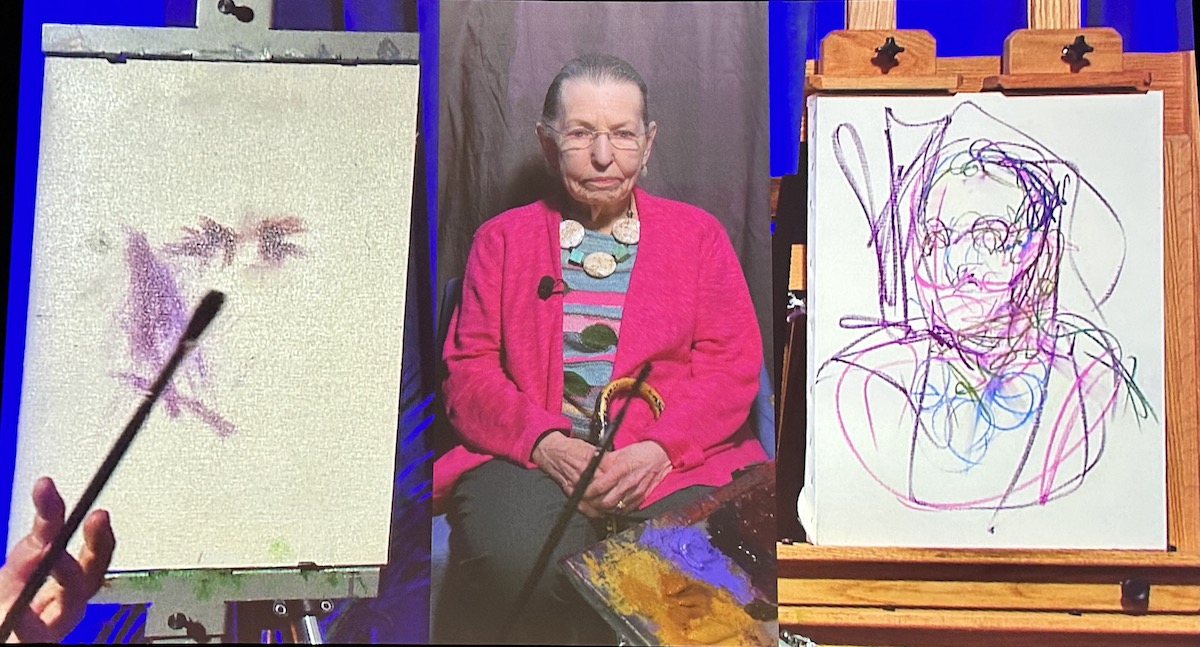
The evening concluded with the Gala Banquet and Awards Presentation in which the new Signature Status members and the twenty finalists of the International Portrait Competition” were honored and the winners were elected from among them.
Below you will find the poem, “When Earth’s Last Picture Is Painted” written by Rudyard Kipling, and published in the New York Sun, Sunday, August 28, 1892, masterfully recited by artist Judith Carducci.
“When Earth’s Last Picture Is Painted” by Rudyard Kipling
When Earth’s last picture is painted and the tubes are twisted and dried,
When the oldest colors have faded, and the youngest critic has died,
We shall rest, and faith, we shall need it – lie down for an aeon or two,
Till the Master of All Good Workmen Shall put us to work anew.
And those that were good shall be happy: they shall sit in a golden chair;
They shall splash at a ten-league canvas with brushes of comet’s hair.
They shall find real saints to draw from – Magdalene, Peter, and Paul;
They shall work for an age at a sitting and never be tired at all!
And only the Master shall praise us, and only the Master shall blame;
And no one will work for the money, and no one will work for the fame,
But each for the joy of the working, and each, in his separate star,
Shall draw the Thing as he sees It for the God of Things as They are!
(on the title: The final works demonstration by Rose Frantzen and Jeff Hein)
